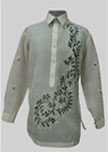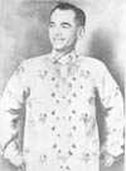Barong Tagalog
 The Barong Tagalog can be worn at formal and informal occasions, for day and evening wear, for business and at holiday. Barong Tagalog is the wear in the Philippines.
The Barong Tagalog can be worn at formal and informal occasions, for day and evening wear, for business and at holiday. Barong Tagalog is the wear in the Philippines.
The Barong Tagalog has a long tradition of more than a century. The line of the Barong Tagalog begins from the Spanish rule. Barongs were usually made of thin fabric almost transparent and with no pockets; so that the Spaniards could see that the person wearing was not bearing any weapon under the garment. The Spanish rulers demanded the Filipinos (Indios)Used in Spanish Colonial times for the ethnic Malays in the Philippines, who were not called Filipinos in Spanish Colonial times to wear a Barong Tagalog. At that time when some Filipinos became successful business men or successful in agricultural and were able to obtain title to lands, these lucky and more important middle classmen had to wear the Barong Tagalog just as Spanish rulers demand.
If you are in need of a Barong Tagalog and you want to be informed about Barong Tagalog, browse our site or visit other feature websites. Here you will find all you need to know.
History
 During the Spanish occupation of the Philippines (over 300 years from 1561-1889) the barong tagalog was required by the Spanish government for Filipinos (Indios)Used in Spanish Colonial times for the ethnic Malays in the Philippines, who were not called Filipinos in Spanish Colonial times to be worn at most times to show the difference betweenthe rich and the poor.. When the Spaniards colonized the Filipinos, they had to make it abundantly clear who the boss was through the imposition of a dress code. Men were not allowed to tuck their shirttails in. That was the mark of his inferior status. Filipinos (Indios)Used in Spanish Colonial times for the ethnic Malays in the Philippines, who were not called Filipinos in Spanish Colonial times to be worn at most times to show the difference between the rich and the poor. The poor who serve the rich must always be in uniform. They are in uniform to immediately distinguish them from the employers. read more »
During the Spanish occupation of the Philippines (over 300 years from 1561-1889) the barong tagalog was required by the Spanish government for Filipinos (Indios)Used in Spanish Colonial times for the ethnic Malays in the Philippines, who were not called Filipinos in Spanish Colonial times to be worn at most times to show the difference betweenthe rich and the poor.. When the Spaniards colonized the Filipinos, they had to make it abundantly clear who the boss was through the imposition of a dress code. Men were not allowed to tuck their shirttails in. That was the mark of his inferior status. Filipinos (Indios)Used in Spanish Colonial times for the ethnic Malays in the Philippines, who were not called Filipinos in Spanish Colonial times to be worn at most times to show the difference between the rich and the poor. The poor who serve the rich must always be in uniform. They are in uniform to immediately distinguish them from the employers. read more »






